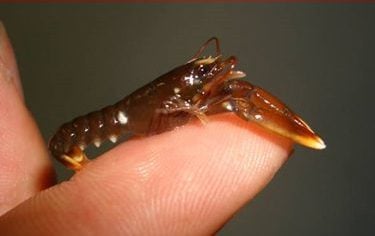It’s A Lobster’s Life
All living creatures have a life cycle. Humans, animals—even the creatures under the sea. And as much as they’re a part of our culinary life, lobsters have a unique life cycle that’s all their own. But you’d be surprised to know how complex it is, right from the very start…
Leapin’ Larva!
 Stage I Lobster Larvae from the Aegir Havbruk Company
Stage I Lobster Larvae from the Aegir Havbruk CompanyLobstermen call them “bugs”, which is probably a fairly accurate description, but the freshly hatched lobster doesn’t resemble an adult lobster in the least. It’s hatched with legs that have feathery hairs on them to enable them to swim right after birth (there’s no time to lose in the sea!).
For the first month of their young lives, they have to be very careful, as they’re prey for seabirds or any larger sea inhabitants (which is just about everything!). They’re easy pickings because most lobster larva typically swim within the 1st meter of the surface of the sea. And it’s within this area that as it grows, it will lose its shell (molt) over three times before it starts to resemble a small-scale adult lobster.
 Lobster Larvae Stages from the Aegir Havbruk Company
Lobster Larvae Stages from the Aegir Havbruk Company
At the time that a lobster enters its “fourth” stage, it’s still quite young; between 15 days and a month old. Although it can swim quite well, it does a lot of bouncing about in the water column, which could be mistaken for floundering, but alas, there’s a method to its madness...it’s making an earnest attempt to seek out permanent digs at the bottom of the sea floor.
 Lobster Larvae from State of Maine Department of Marine Resources
Lobster Larvae from State of Maine Department of Marine ResourcesFor a number of weeks, the larva may try out many different habitats, like Cape Cod’s salt marsh peat. But lobsters are picky! They prefer to find place like a hard sea floor with plenty of places to hide. A good location for them has been cobble. Very densely populated with other lobsters, there might be over 10,000 eggs from one female. Plus, only 1/10 of 1% or about 10 larva, is likely to survive its initial weeks.
Once it finds a lasting home, a fifth molting takes place. Now, as a small lobster on its own, it still needs to explore its environs. But it doesn’t go it alone...there are many denizens of the deep who aren’t too friendly to junior. Sea life like eelpot, skates, sculpin, cod, and even other lobsters will be on the lookout for our little friend if he ventures out.
The first year of a lobster’s food supply comes from small, water-transported prey that the lobster sends through its living quarters using abdominal pleopods (these are small projections known as “swimmerrets” which lay under the lobster’s bendable stomach, or “tail”.) Until the lobster reaches the ripe age of four, it spends most of its time hiding under small rocks and seaweed, just laying in wait for food that happens to float its way. Tiny shrimp-like beings, isopods, amphipods and isopods -- or “sand fleas” are also on its menu.
Small lobsters do not venture out much from their tight hiding places, because if they’re out for even a minute or two, fish will attack them. So they stay put as they grow, little by little.
Home is for hiding
The ideal “home” for lobsters lies on the ocean floor. But with so many options — mud, sand, gravel, or small stones known as cobble (get it, cobblestones?), choosy lobsters choose the cobble because it’s easier to stay out of sight of predators by hiding in between spaces and openings, but still allows them to catch falling food. As a lobster grows into its “adolescent” years, areas with bigger boulders are more preferred. Once they become adult, what the heck...the sea’s their playground and they go anywhere they want, as far as they want. And they also get left alone now by many predators (go pick on something your own size!).
Shell games
A lobster molts, or sheds its shell close to 25 times in only its first 5 years. When it’s an adult, it may shed its shell one time a year or maybe within a few years. A female lobster might go two years without a molt when they’re breeding. That’s because molting is not easy! Before a lobster molts, the flesh inside its claws shrivels down to a quarter of its size so that water and blood can be released. This process helps to weaken the shell. This next part is a bit detailed, so read carefully!
While this is all happening, the flesh is also in the process of recouping some calcium that will help the new shell harden. In a “gastrolith” (also known as a stomach stone, located on the outside of the foregut, which is a set of grinding teeth that can grind food into fine particles), some of that calcium gets replenished and reserved. The old shell begins to crack following a joint that separates the back shell from the tail, and the middle of the back.
With the lobster lying on its side, its body flexes a few times to free itself from the old shell, which is now cracked and useless. The lobster’s claw muscles can sometimes end up getting caught in a tight knuckle joint while the lobster is molting, and if that happens, the lobster has to give up the claw and lose both the flesh and shell.